parking brake TOYOTA TACOMA 2016 Owners Manual (in English)
[x] Cancel search | Manufacturer: TOYOTA, Model Year: 2016, Model line: TACOMA, Model: TOYOTA TACOMA 2016Pages: 640, PDF Size: 40.18 MB
Page 3 of 640
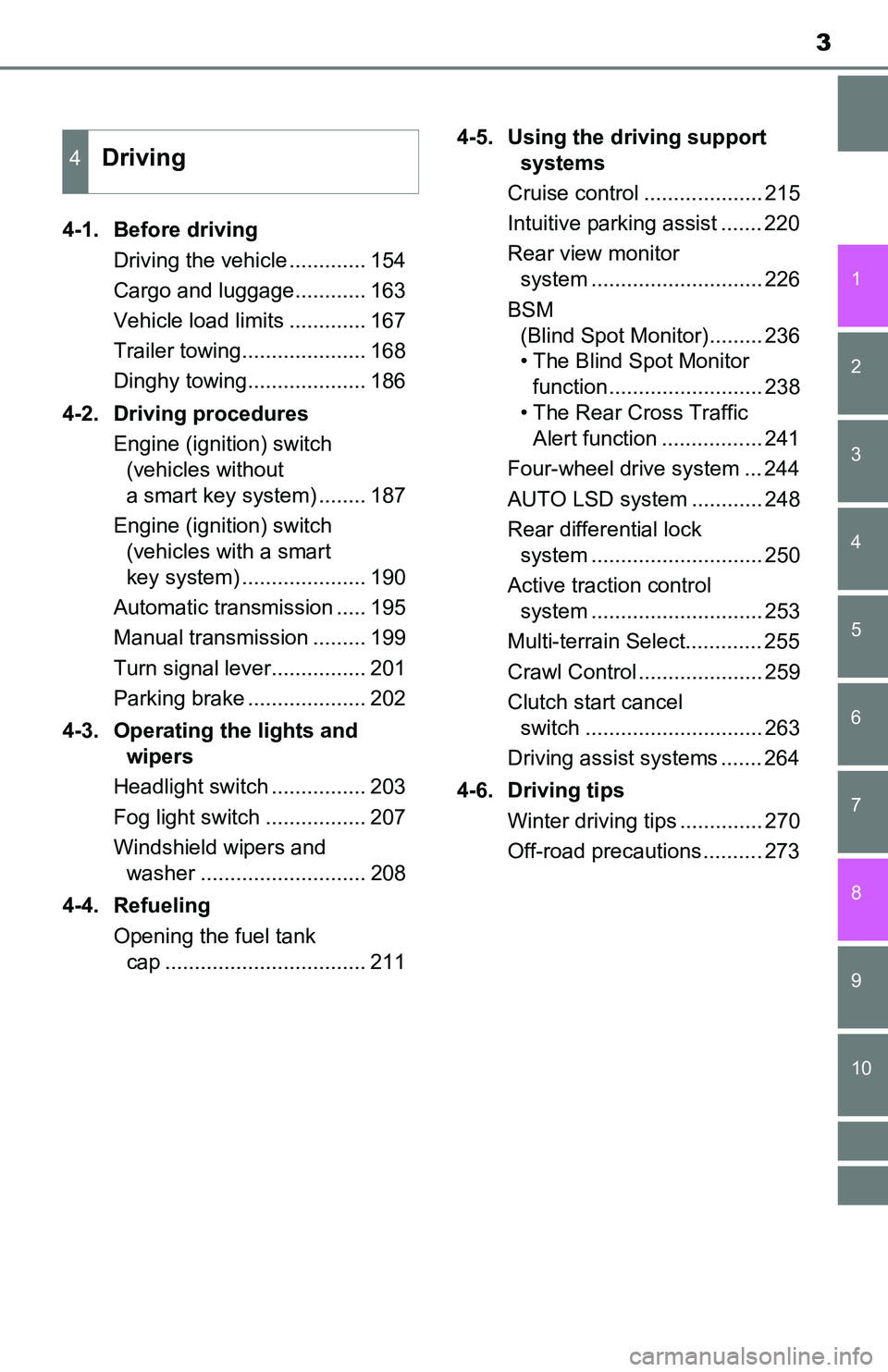
3
1
9 8
7 5 4
3
2
10
6
4-1. Before driving
Driving the vehicle ............. 154
Cargo and luggage............ 163
Vehicle load limits ............. 167
Trailer towing..................... 168
Dinghy towing.................... 186
4-2. Driving procedures
Engine (ignition) switch
(vehicles without
a smart key system) ........ 187
Engine (ignition) switch
(vehicles with a smart
key system) ..................... 190
Automatic transmission ..... 195
Manual transmission ......... 199
Turn signal lever................ 201
Parking brake .................... 202
4-3. Operating the lights and
wipers
Headlight switch ................ 203
Fog light switch ................. 207
Windshield wipers and
washer ............................ 208
4-4. Refueling
Opening the fuel tank
cap .................................. 2114-5. Using the driving support
systems
Cruise control .................... 215
Intuitive parking assist ....... 220
Rear view monitor
system ............................. 226
BSM
(Blind Spot Monitor)......... 236
• The Blind Spot Monitor
function.......................... 238
• The Rear Cross Traffic
Alert function ................. 241
Four-wheel drive system ... 244
AUTO LSD system ............ 248
Rear differential lock
system ............................. 250
Active traction control
system ............................. 253
Multi-terrain Select............. 255
Crawl Control ..................... 259
Clutch start cancel
switch .............................. 263
Driving assist systems ....... 264
4-6. Driving tips
Winter driving tips .............. 270
Off-road precautions .......... 273
4Driving
Page 17 of 640
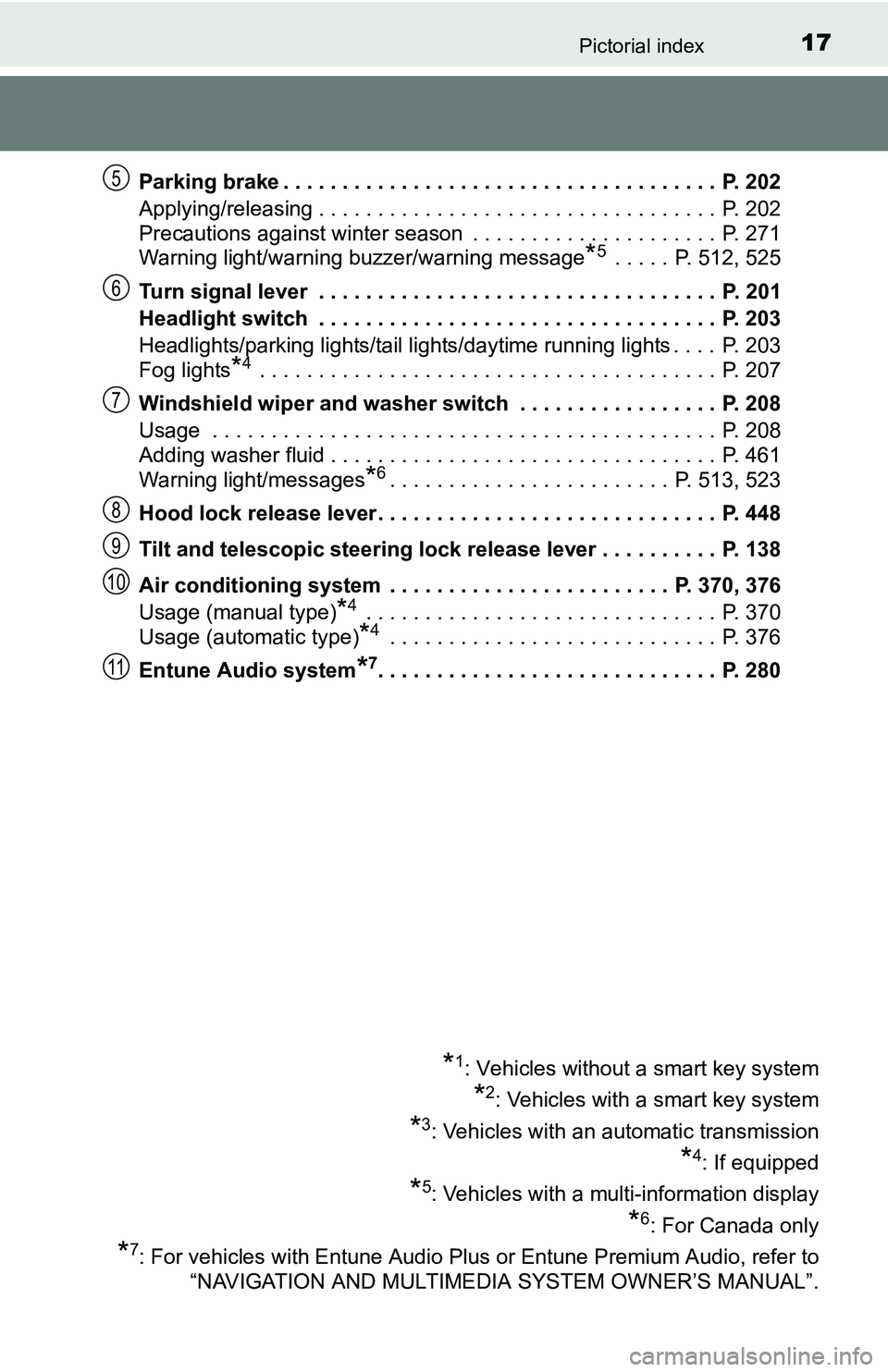
17Pictorial index
Parking brake . . . . . . . . . . . . . . . . . . . . . . . . . . . . . . . . . . . . . P. 202
Applying/releasing . . . . . . . . . . . . . . . . . . . . . . . . . . . . . . . . . . P. 202
Precautions against winter season . . . . . . . . . . . . . . . . . . . . . P. 271
Warning light/warning buzzer/warning message
*5 . . . . . P. 512, 525
Turn signal lever . . . . . . . . . . . . . . . . . . . . . . . . . . . . . . . . . . P. 201
Headlight switch . . . . . . . . . . . . . . . . . . . . . . . . . . . . . . . . . . P. 203
Headlights/parking lights/tail lights/daytime running lights . . . . P. 203
Fog lights
*4 . . . . . . . . . . . . . . . . . . . . . . . . . . . . . . . . . . . . . . . P. 207
Windshield wiper and washer switch . . . . . . . . . . . . . . . . . P. 208
Usage . . . . . . . . . . . . . . . . . . . . . . . . . . . . . . . . . . . . . . . . . . . P. 208
Adding washer fluid . . . . . . . . . . . . . . . . . . . . . . . . . . . . . . . . . P. 461
Warning light/messages
*6. . . . . . . . . . . . . . . . . . . . . . . . P. 513, 523
Hood lock release lever. . . . . . . . . . . . . . . . . . . . . . . . . . . . . P. 448
Tilt and telescopic steering lock release lever . . . . . . . . . . P. 138
Air conditioning system . . . . . . . . . . . . . . . . . . . . . . . . P. 370, 376
Usage (manual type)
*4 . . . . . . . . . . . . . . . . . . . . . . . . . . . . . . P. 370
Usage (automatic type)
*4 . . . . . . . . . . . . . . . . . . . . . . . . . . . . P. 376
Entune Audio system
*7. . . . . . . . . . . . . . . . . . . . . . . . . . . . . P. 280
*1: Vehicles without a smart key system
*2: Vehicles with a smart key system
*3: Vehicles with an automatic transmission
*4: If equipped
*5: Vehicles with a multi-information display
*6: For Canada only
*7: For vehicles with Entune Audio Plus or Entune Premium Audio, refer to
“NAVIGATION AND MULTIMEDIA SYSTEM OWNER’S MANUAL”.
5
6
7
8
9
10
11
Page 84 of 640

842. Instrument cluster
*1: These lights turn on when the engine switch is turned to the “ON” position
(vehicles without a smart key system) or IGNITION ON mode (vehicles
with a smart key system) to indicate that a system check is being per-
formed. They will turn off after the engine is started, or after a few seconds.
There may be a malfunction in a system if the lights do not come on, or if
the lights do not turn off. Have the vehicle inspected by your Toyota dealer
for details.
*2: Vehicles without a multi-information display.
*3: The light comes on to indicate a malfunction.
*4: Vehicles with an automatic transmission.
*5: Vehicles with a multi-information display.
*6: Vehicles without a multi-information display:
The light flashes rapidly in yellow to indicate a malfunction.
Vehicles with a multi-information display:
The light flashes to indicate a malfunction.
*7: 2GR-FKS engine only
Low fuel level warning
light (P. 512)*1, 2
Brake Override System
warning light (P. 513)
Seat belt reminder light
(P. 512)
*1
(If equipped)
Tire pressure warning
light (P. 513)
(U.S.A.)
Parking brake indicator
(P. 512)*1, 2
(Canada)
Low windshield washer
fluid warning light
(P. 513)
(Canada)
Parking brake indicator
(P. 512)*2, 7Low engine oil level
warning light (P. 514)
*1, 5
Master warning light
(P. 513)
*1, 2
(U.S.A.)
Maintenance required
remainder light
(P. 514)
*1, 2
(If equipped)
BSM (Blind Spot Moni-
tor) warning light
(P. 513)
Page 86 of 640
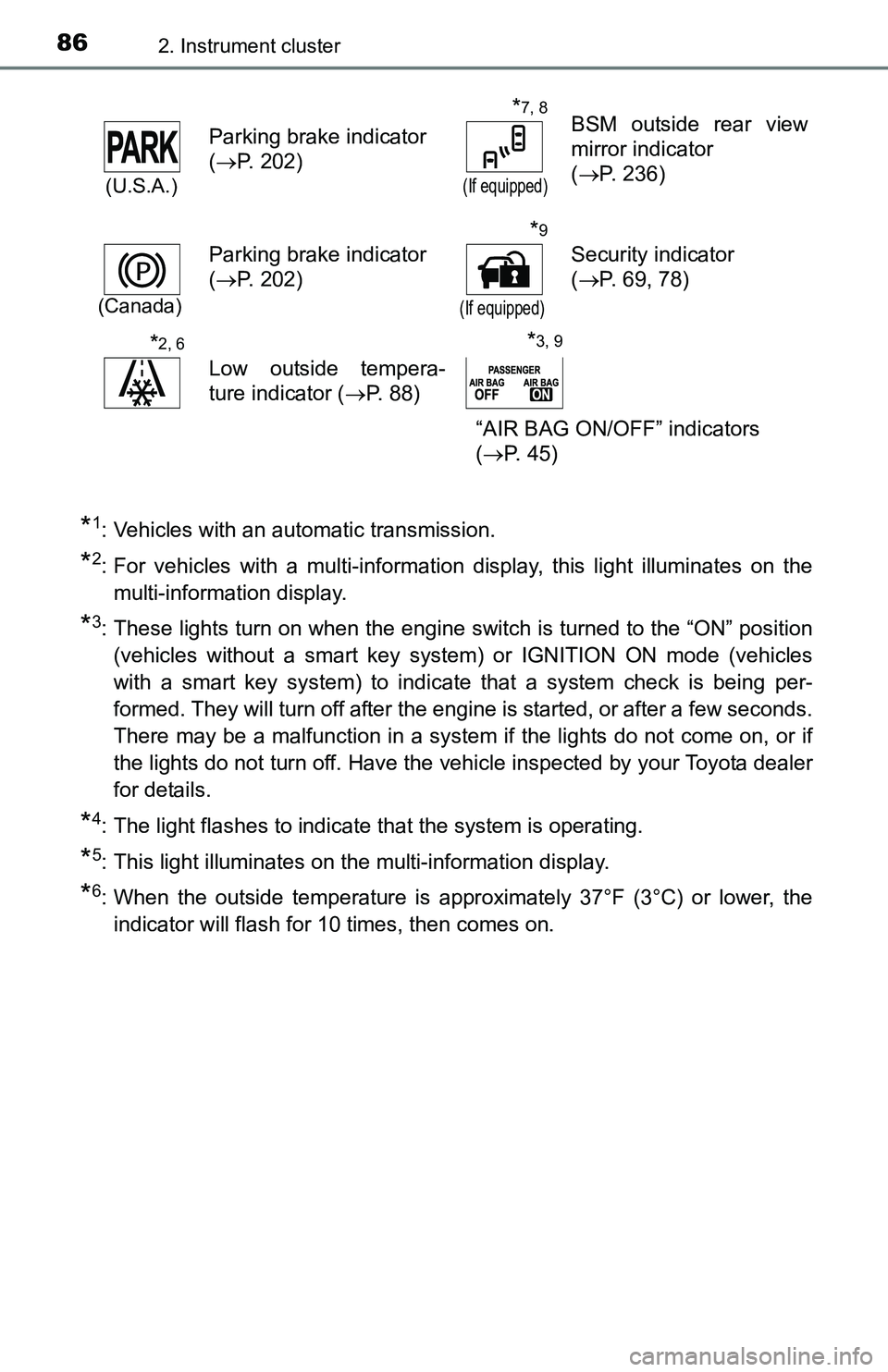
862. Instrument cluster
*1: Vehicles with an automatic transmission.
*2: For vehicles with a multi-information display, this light illuminates on the
multi-information display.
*3: These lights turn on when the engine switch is turned to the “ON” position
(vehicles without a smart key system) or IGNITION ON mode (vehicles
with a smart key system) to indicate that a system check is being per-
formed. They will turn off after the engine is started, or after a few seconds.
There may be a malfunction in a system if the lights do not come on, or if
the lights do not turn off. Have the vehicle inspected by your Toyota dealer
for details.
*4: The light flashes to indicate that the system is operating.
*5: This light illuminates on the multi-information display.
*6: When the outside temperature is approximately 37°F (3°C) or lower, the
indicator will flash for 10 times, then comes on.
(U.S.A.)
Parking brake indicator
(P. 202)
*7, 8
(If equipped)
BSM outside rear view
mirror indicator
(P. 236)
(Canada)
Parking brake indicator
(P. 202)
*9
(If equipped)
Security indicator
(P. 69, 78)
*2, 6
Low outside tempera-
ture indicator (P. 88)
“AIR BAG ON/OFF” indicators
(P. 45)
*3, 9
Page 133 of 640
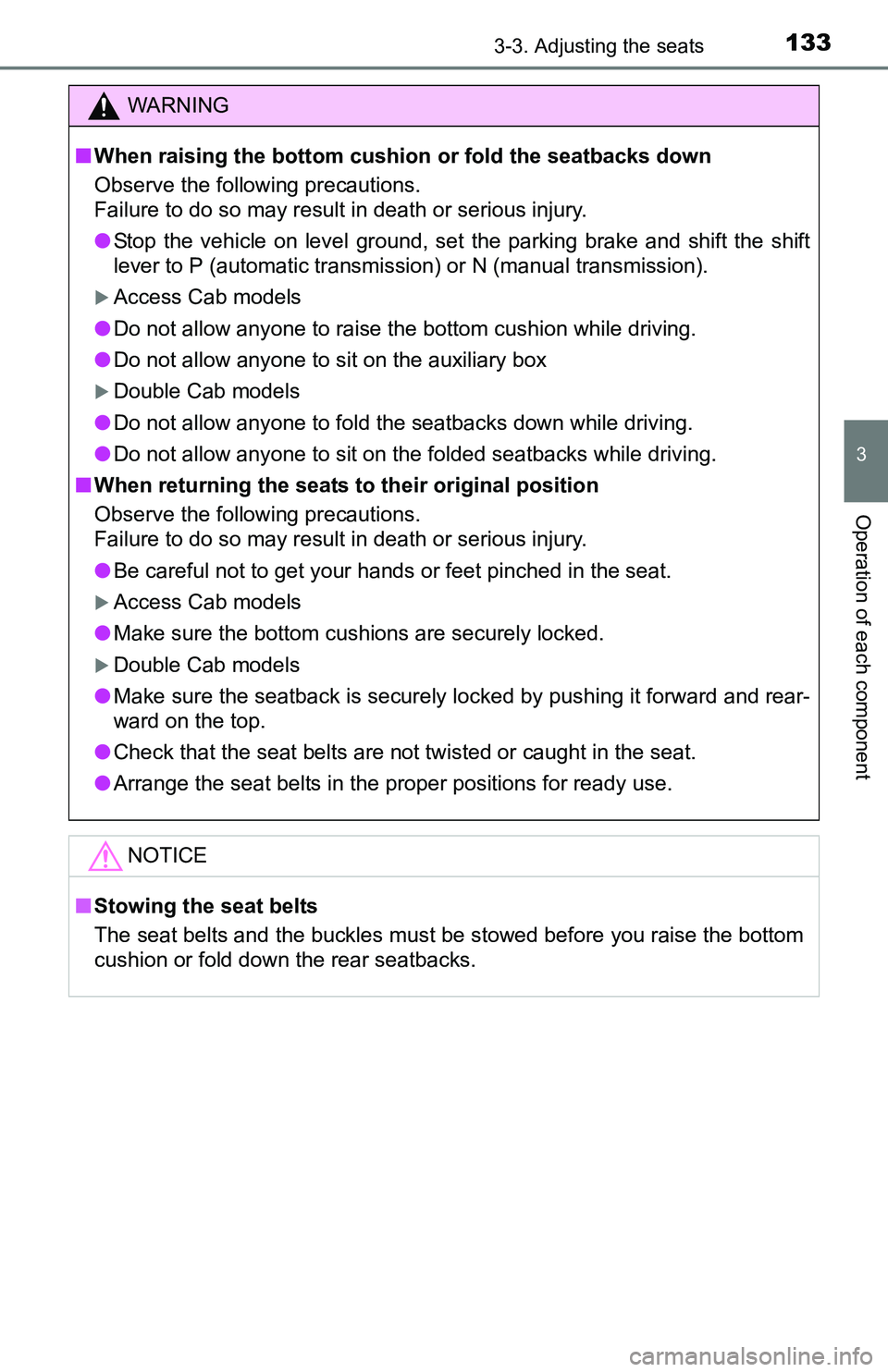
1333-3. Adjusting the seats
3
Operation of each component
WARNING
■When raising the bottom cushion or fold the seatbacks down
Observe the following precautions.
Failure to do so may result in death or serious injury.
●Stop the vehicle on level ground, set the parking brake and shift the shift
lever to P (automatic transmission) or N (manual transmission).
Access Cab models
●Do not allow anyone to raise the bottom cushion while driving.
●Do not allow anyone to sit on the auxiliary box
Double Cab models
●Do not allow anyone to fold the seatbacks down while driving.
●Do not allow anyone to sit on the folded seatbacks while driving.
■When returning the seats to their original position
Observe the following precautions.
Failure to do so may result in death or serious injury.
●Be careful not to get your hands or feet pinched in the seat.
Access Cab models
●Make sure the bottom cushions are securely locked.
Double Cab models
●Make sure the seatback is securely locked by pushing it forward and rear-
ward on the top.
●Check that the seat belts are not twisted or caught in the seat.
●Arrange the seat belts in the proper positions for ready use.
NOTICE
■Stowing the seat belts
The seat belts and the buckles must be stowed before you raise the bottom
cushion or fold down the rear seatbacks.
Page 153 of 640

153
4Driving
4-1. Before driving
Driving the vehicle ............. 154
Cargo and luggage ........... 163
Vehicle load limits ............. 167
Trailer towing..................... 168
Dinghy towing ................... 186
4-2. Driving procedures
Engine (ignition) switch
(vehicles without
a smart key system) ........ 187
Engine (ignition) switch
(vehicles with a smart
key system) ..................... 190
Automatic transmission ..... 195
Manual transmission ......... 199
Turn signal lever................ 201
Parking brake .................... 202
4-3. Operating the lights and
wipers
Headlight switch ................ 203
Fog light switch ................. 207
Windshield wipers and
washer ............................ 208
4-4. Refueling
Opening the fuel tank
cap .................................. 2114-5. Using the driving support
systems
Cruise control .................... 215
Intuitive parking assist....... 220
Rear view monitor
system ............................ 226
BSM
(Blind Spot Monitor) ........ 236
• The Blind Spot Monitor
function ......................... 238
• The Rear Cross Traffic
Alert function ................. 241
Four-wheel drive system ... 244
AUTO LSD system............ 248
Rear differential lock
system ............................ 250
Active traction control
system ............................ 253
Multi-terrain Select ............ 255
Crawl Control .................... 259
Clutch start cancel
switch .............................. 263
Driving assist systems ...... 264
4-6. Driving tips
Winter driving tips ............. 270
Off-road precautions ......... 273
Page 154 of 640
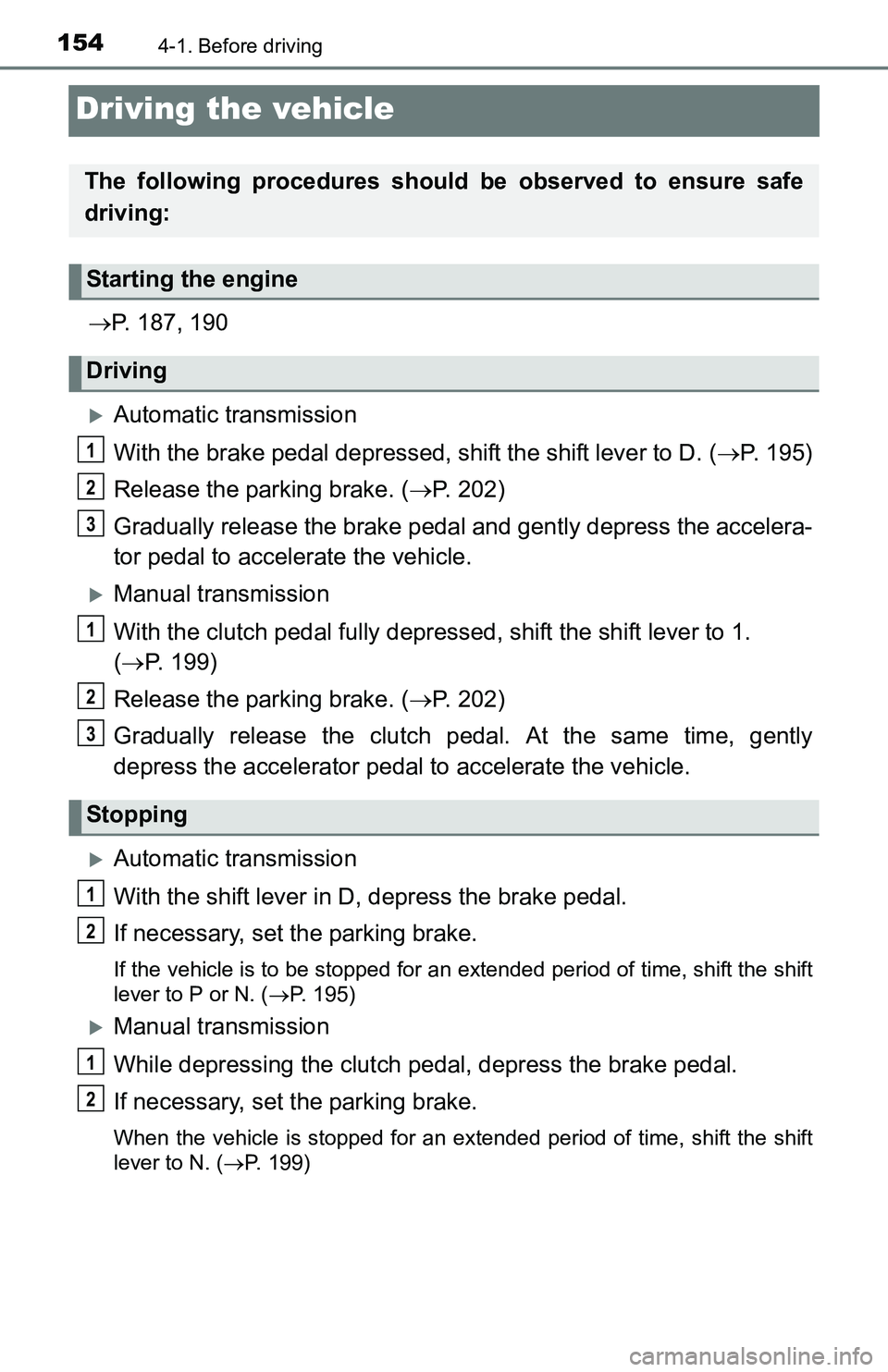
1544-1. Before driving
Driving the vehicle
P. 187, 190
Automatic transmission
With the brake pedal depressed, shift the shift lever to D. (P. 195)
Release the parking brake. (P. 202)
Gradually release the brake pedal and gently depress the accelera-
tor pedal to accelerate the vehicle.
Manual transmission
With the clutch pedal fully depressed, shift the shift lever to 1.
(P. 199)
Release the parking brake. (P. 202)
Gradually release the clutch pedal. At the same time, gently
depress the accelerator pedal to accelerate the vehicle.
Automatic transmission
With the shift lever in D, depress the brake pedal.
If necessary, set the parking brake.
If the vehicle is to be stopped for an extended period of time, shift the shift
lever to P or N. (P. 195)
Manual transmission
While depressing the clutch pedal, depress the brake pedal.
If necessary, set the parking brake.
When the vehicle is stopped for an extended period of time, shift the shift
lever to N. (P. 199)
The following procedures should be observed to ensure safe
driving:
Starting the engine
Driving
Stopping
1
2
3
1
2
3
1
2
1
2
Page 155 of 640
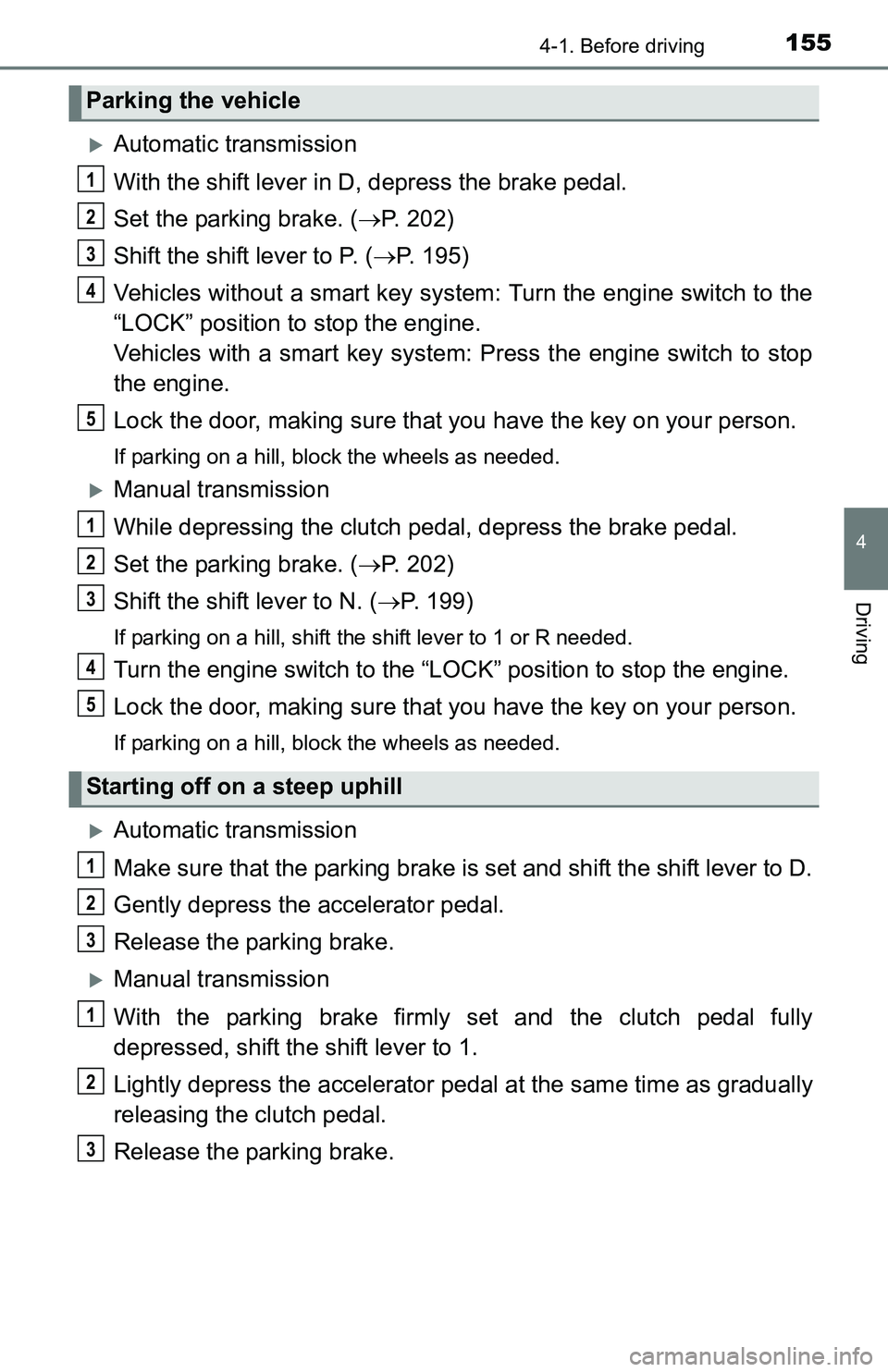
1554-1. Before driving
4
Driving
Automatic transmission
With the shift lever in D, depress the brake pedal.
Set the parking brake. (P. 202)
Shift the shift lever to P. (P. 195)
Vehicles without a smart key system: Turn the engine switch to the
“LOCK” position to stop the engine.
Vehicles with a smart key system: Press the engine switch to stop
the engine.
Lock the door, making sure that you have the key on your person.
If parking on a hill, block the wheels as needed.
Manual transmission
While depressing the clutch pedal, depress the brake pedal.
Set the parking brake. (P. 202)
Shift the shift lever to N. (P. 199)
If parking on a hill, shift the shift lever to 1 or R needed.
Turn the engine switch to the “LOCK” position to stop the engine.
Lock the door, making sure that you have the key on your person.
If parking on a hill, block the wheels as needed.
Automatic transmission
Make sure that the parking brake is set and shift the shift lever to D.
Gently depress the accelerator pedal.
Release the parking brake.
Manual transmission
With the parking brake firmly set and the clutch pedal fully
depressed, shift the shift lever to 1.
Lightly depress the accelerator pedal at the same time as gradually
releasing the clutch pedal.
Release the parking brake.
Parking the vehicle
Starting off on a steep uphill
1
2
3
4
5
1
2
3
4
5
1
2
3
1
2
3
Page 159 of 640

1594-1. Before driving
4
Driving
WARNING
■If you hear a squealing or scraping noise (brake pad wear limit indica-
tors)
Have the brake pads checked and replaced by your Toyota dealer as soon
as possible.
Rotor damage may result if the pads are not replaced when needed.
It is dangerous to drive the vehicle when the wear limits of the brake pads
and/or those of the brake discs are exceeded.
■When the vehicle is stopped
●Do not race the engine.
If the vehicle is in any gear other than P (automatic transmission only) or
N, the vehicle may accelerate suddenly and unexpectedly, causing an
accident.
●On vehicles with an automatic transmission, in order to prevent accidents
due to the vehicle rolling away, always keep depressing the brake pedal
while the engine is running, and apply the parking brake as necessary.
●If the vehicle is stopped on an incline, in order to prevent accidents caused
by the vehicle rolling forward or backward, always depress the brake pedal
and securely apply the parking brake as needed.
●Avoid revving or racing the engine.
Running the engine at high speed while the vehicle is stopped may cause
the exhaust system to overheat, which could result in a fire if combustible
material is nearby.
■When the vehicle is parked
●Do not leave glasses, cigarette lighters, spray cans, or soft drink cans in
the vehicle when it is in the sun.
Doing so may result in the following:
• Gas may leak from a cigarette lighter or spray can, and may lead to a
fire.
• The temperature inside the vehicle may cause the plastic lenses and
plastic material of glasses to deform or crack.
• Soft drink cans may rupture, causing the contents to spray over the
interior of the vehicle, and may also cause a short circuit in the vehicle’s
electrical components.
●Do not leave cigarette lighters in the vehicle. If a cigarette lighter is in a
place such as the glove box or on the floor, it may be lit accidentally when
luggage is loaded or the seat is adjusted, causing a fire.
●Do not attach adhesive discs to the windshield or windows. Do not place
containers such as air fresheners on the instrument panel or dashboard.
Adhesive discs or containers may act as lenses, causing a fire in the vehi-
cle.
Page 160 of 640
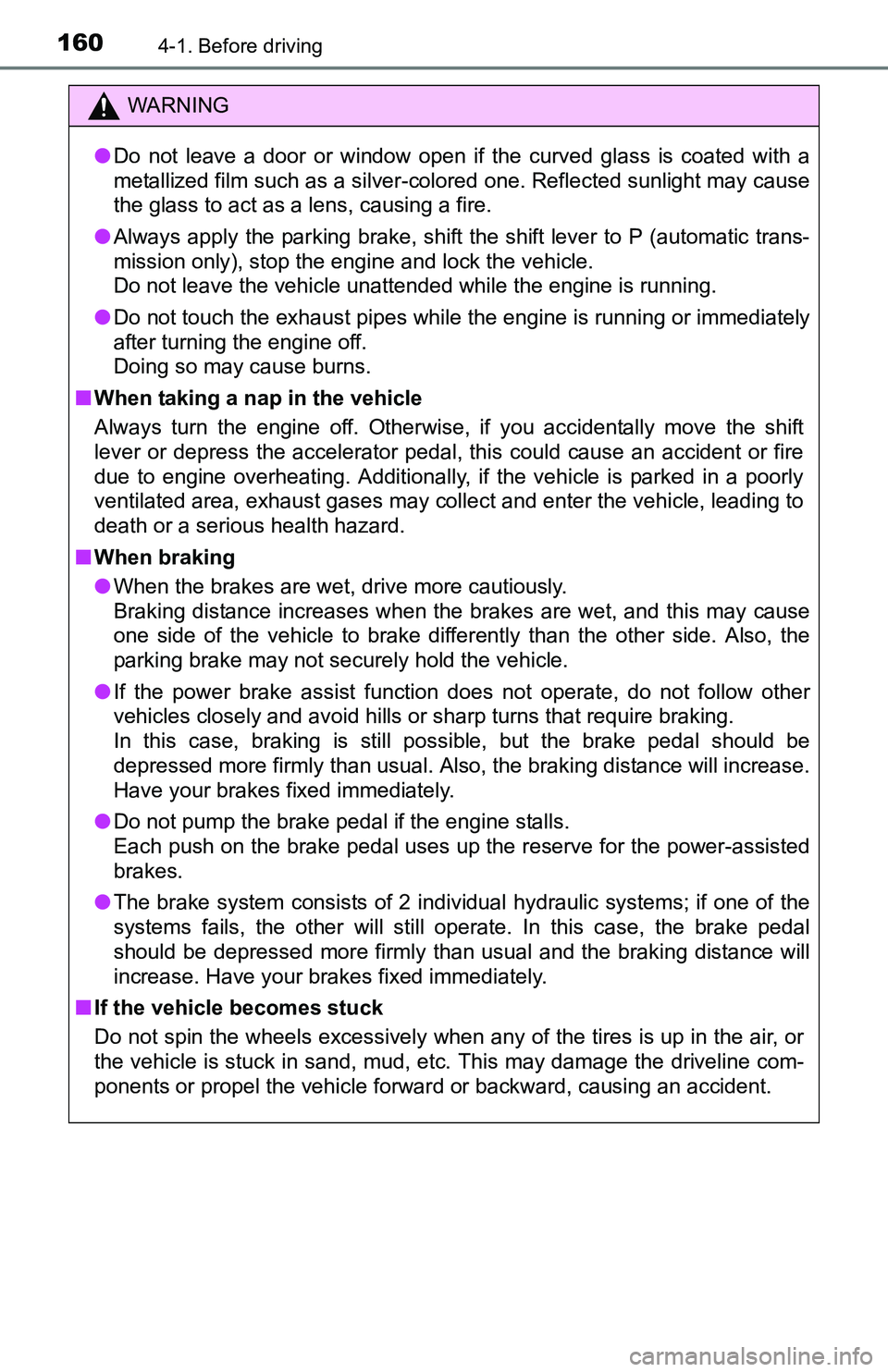
1604-1. Before driving
WARNING
●Do not leave a door or window open if the curved glass is coated with a
metallized film such as a silver-colored one. Reflected sunlight may cause
the glass to act as a lens, causing a fire.
●Always apply the parking brake, shift the shift lever to P (automatic trans-
mission only), stop the engine and lock the vehicle.
Do not leave the vehicle unattended while the engine is running.
●Do not touch the exhaust pipes while the engine is running or immediately
after turning the engine off.
Doing so may cause burns.
■When taking a nap in the vehicle
Always turn the engine off. Otherwise, if you accidentally move the shift
lever or depress the accelerator pedal, this could cause an accident or fire
due to engine overheating. Additionally, if the vehicle is parked in a poorly
ventilated area, exhaust gases may collect and enter the vehicle, leading to
death or a serious health hazard.
■When braking
●When the brakes are wet, drive more cautiously.
Braking distance increases when the brakes are wet, and this may cause
one side of the vehicle to brake differently than the other side. Also, the
parking brake may not securely hold the vehicle.
●If the power brake assist function does not operate, do not follow other
vehicles closely and avoid hills or sharp turns that require braking.
In this case, braking is still possible, but the brake pedal should be
depressed more firmly than usual. Also, the braking distance will increase.
Have your brakes fixed immediately.
●Do not pump the brake pedal if the engine stalls.
Each push on the brake pedal uses up the reserve for the power-assisted
brakes.
●The brake system consists of 2 individual hydraulic systems; if one of the
systems fails, the other will still operate. In this case, the brake pedal
should be depressed more firmly than usual and the braking distance will
increase. Have your brakes fixed immediately.
■If the vehicle becomes stuck
Do not spin the wheels excessively when any of the tires is up in the air, or
the vehicle is stuck in sand, mud, etc. This may damage the driveline com-
ponents or propel the vehicle forward or backward, causing an accident.